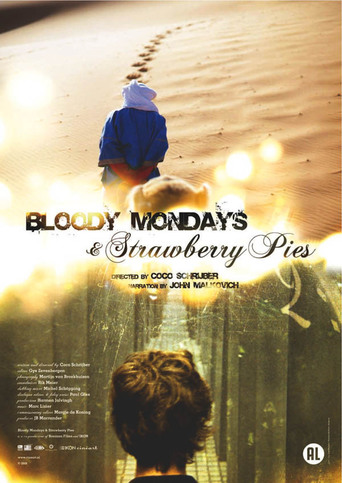

A different way of telling a story
... View MoreFanciful, disturbing, and wildly original, it announces the arrival of a fresh, bold voice in American cinema.
... View MoreAll of these films share one commonality, that being a kind of emotional center that humanizes a cast of monsters.
... View MoreThe best films of this genre always show a path and provide a takeaway for being a better person.
... View MoreThe early sequences of Bloody Mondays and Strawberry Pies, directed by Dutch filmmaker Coco Schrijber, present a striking series of shots: an endless desert landscape, a young girl wandering through a maze of gray obelisks, news footage of a school shooting. Above all this is John Malkovich's sparse, cryptic narration drawn from passages of Dostoyevksy's Notes from Underground and Brett Easton Ellison's 1991 novel, American Psycho.American television audiences--thumbs ever hovering over the remote control--are never allowed to be confused long enough to get used to it, so some viewers will chafe early on at Schrijber's willingness to put off telling us what these images mean, but the camera work is lyrical and compelling, and soon enough those opening scenes--and the title itself--begin to make sense. In the end, the film's argument is fairly straightforward, stated in the opening scene: Greta Garbo's wry observation that "life would be great if we only knew what to do with it."Bloody Mondays is both a subtle critique of the over-hurried lifestyle and a serene and fascinating meditation on the multiple ways humans experience time: Schrijber interviews harried Wall-Street brokers who make rapid-fire sales calls 60 hours a week then introduces an artist who spends his days painting an immense canvas he has filled with tiny numbers, from one to five million and counting. In another sequence a Moroccan camel driver reclines atop a sand dune, laughing about tourists who must always know what time it is, what day of the week. Later we see a jeweler's hands caressing gem-encrusted $400,000 wristwatches, a 92 year-old former British spy struggling to recall the grandest time in her life and a young factory girl working numbly at a conveyor belt assembling strawberry pies, each rolling by like the days of her passing youth. Through these intertwined stories, Bloody Mondays and Strawberry Pies takes a cohesive shape, ultimately rewarding viewers with a wholly original film-going experience and asking the profound and unsettling questions that all great art strives to ask.
... View MoreWatching this at my local screening room was a very significant experience. There's method to the madness of this movie - it's not just "trippy". But nevertheless you might not "figure it out" ...and it doesn't really matter to your enjoyment. In my opinion this is a must see for the art house crowd. (I didn't mark my comments as a "spoiler" because this movie doesn't really have any plot line to "spoil".) One might suspect a movie that claims to be about "boredom" to move pretty slowly, maybe even making the viewer sit through some "watching paint dry" sequences. The reality is just the opposite; most of the time the screen is full of more than you can absorb! Depending on how you view it, the theme might not even be "boredom". It could just as well be the various paces of different humans, life in the fast lane, or even the meaning of life.There's a lot of unusual camera work, including quite a few extreme closeups of faces. Even during interview sequences there will suddenly be closeups, making the viewer wonder how they got the camera so close without botching the interview. At one point you can enjoy an entire screen filled with a mouth biting into a sandwich. At another point a subject explicitly points at and calls out the camera.Here's my attempt at a description of the general style of this movie: start with unusual and quirky material about people, a-la Ira Glass's This American Life radio show. Now make it the "best of ..."; in other words punch it up a notch. Now give the lead to the video instead of the audio (actually make _both_ the video and the audio important). Now make it "arty". Now inter-cut pieces of the various segments by theme, rather than telling the stories sequentially.The audio is of course in several languages, as portions of the film are in half a dozen different countries. There are very careful English subtitles, just enough to let you follow the thread, but nothing even close to the distraction of a literal translation of absolutely everything. (And as is common with very careful subtitles, thick accents get treated just like other languages. And important signs are translated just like the sound track.) Sometimes the audio is synced with the video; sometimes it's by the character in the video but at a different time; sometimes it's an unseen interviewer; and sometimes it's an impressive "narration" series of readings from famous sources. Not all of the narration readings are in English, and not all of those are translated (most likely depending on whether the "meaning" or the "feel" of those words is more important to the film at that point).
... View More